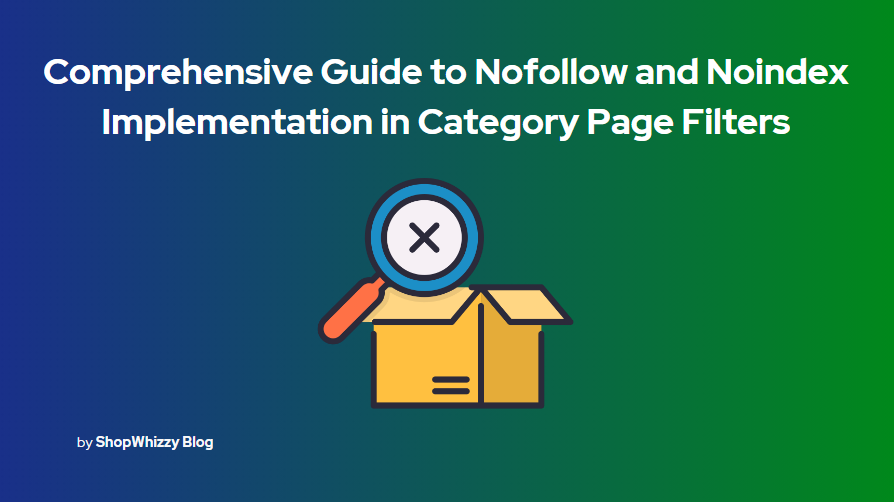Introduction
In the vast digital landscape of the internet, websites compete fiercely for attention and visibility. Amidst this competition, search engine optimization (SEO) emerges as a crucial strategy for enhancing website performance and attracting organic traffic. Central to effective SEO are the concepts of nofollow and noindex tags, which wield significant influence over how search engines crawl, index, and rank web pages. In this comprehensive guide, we delve deep into the intricacies of these HTML meta tags, exploring their relevance, implementation, and impact on website structure. Drawing from real-world examples and best practices, we uncover the nuances of utilizing nofollow and noindex tags within category page filters, offering actionable insights for optimizing website architecture and maximizing search engine visibility.
Navigating the Complexities of SEO
The digital ecosystem is a vast and dynamic realm, where websites vie for attention amidst an ever-expanding sea of online content. In this landscape, search engine optimization (SEO) emerges as a crucial strategy for enhancing website visibility and driving organic traffic. At the heart of effective SEO lie myriad techniques and methodologies aimed at optimizing website structure, content, and functionality to align with the algorithms of leading search engines such as Google, Bing, and Yahoo.
Among the arsenal of SEO tactics, the strategic implementation of nofollow and noindex tags stands out as a fundamental yet often misunderstood aspect of website optimization. These HTML meta tags exert profound influence over how search engines perceive and interact with webpages, shaping the digital footprint of online entities and impacting their discoverability in search results.
Unraveling the Mysteries of Nofollow and Noindex Tags
Before delving into the intricacies of nofollow and noindex implementation within category page filters, it is imperative to establish a solid understanding of these foundational concepts. At their core, nofollow and noindex tags serve distinct yet complementary purposes in the realm of SEO, governing the flow of link equity and determining the indexability of web pages, respectively.
Deciphering the Nofollow Tag
The nofollow tag, denoted by the HTML attribute rel="nofollow", is a directive embedded within the code of a webpage to instruct search engine crawlers not to follow certain links present on that page. This directive emerged as a response to combat spammy link schemes and manipulate search engine rankings, providing webmasters with a means to control the flow of PageRank and prevent the dilution of link equity across low-quality or irrelevant pages.
Demystifying the Noindex Tag
In contrast to the nofollow tag, the noindex tag operates at a deeper level, influencing the indexability of web pages within search engine databases. When applied to a webpage, the noindex directive signals to search engine crawlers that the content of that page should not be included in search engine results pages (SERPs), effectively rendering it invisible to users searching for relevant queries.
The Case of interprizess.no: A Fictitious Tale of SEO Dilemmas
To illustrate the practical implications of nofollow and noindex implementation, we turn our attention to interprizess.no, a fictional website grappling with issues related to category page filters. Despite its fictitious nature, the challenges faced by interprizess.no mirror those encountered by countless real-world websites navigating the complexities of SEO optimization.
The Predicament of Unruly Category Page Filters
At the heart of interprizess.no's SEO dilemma lies the mismanagement of category page filters, leading to the inadvertent generation of thousands of non-indexable and non-followable URLs. This proliferation of redundant pages not only consumes a valuable crawl budget but also undermines the site's overall structural integrity, hindering search engine crawlers' ability to discern the most relevant and authoritative content.
Consequences of Suboptimal SEO Practices
The ramifications of interprizess.no's suboptimal SEO practices extend far beyond mere inefficiencies in crawl budget allocation. By failing to properly implement nofollow and noindex directives within category page filters, the website inadvertently dilutes its online presence, dispersing link equity across a myriad of inconsequential pages while neglecting to prioritize the indexing of core content assets.
The Path to Redemption: Best Practices for Nofollow and Noindex Implementation
Armed with a deeper understanding of the challenges posed by mismanaged category page filters, we embark on a journey toward redemption, charting a course toward the implementation of best practices for nofollow and noindex utilization. Through a combination of theoretical insights and practical recommendations, we outline a roadmap for optimizing website structure and maximizing search engine visibility.
Embracing URL Parameterization
Central to our strategy for mitigating the adverse effects of category page filters is the adoption of URL parameterization as a means of encapsulating filtration criteria within the URL structure itself. By appending filter parameters to existing URLs, rather than generating entirely new pages, we minimize redundancy and streamline the crawlability of our website's content.
Harnessing the Power of Canonicalization
In tandem with URL parameterization, canonicalization emerges as a potent tool for consolidating variant URLs and signaling to search engines the preferred canonical version of a given page. Through the strategic deployment of canonical tags, we ensure that search engine crawlers prioritize the indexing of primary content assets while relegating filtered variants to secondary status.
Enforcing Nofollow Attributes
To further reinforce our SEO strategy, we advocate for the judicious application of nofollow attributes within category page filters, particularly in the context of internal linking structures. By marking links to filtered variants with the rel="nofollow" attribute, we prevent search engine crawlers from expending valuable resources on indexing non-essential pages, thereby preserving the crawl budget and directing attention towards core content assets.
The Road Ahead: Navigating the Ever-Evolving Landscape of SEO Optimization
As we conclude our exploration of nofollow and noindex implementation within category page filters, it is essential to recognize that SEO optimization is a perpetual journey rather than a destination. In an era marked by continual algorithmic updates and shifting search engine paradigms, the quest for digital relevance and visibility remains an ongoing endeavor, demanding adaptability, and innovation at every turn.
Embracing Agility in SEO Strategy
In the face of uncertainty and ambiguity, agility emerges as a defining trait of successful SEO practitioners. By remaining vigilant to emerging trends and receptive to evolving best practices, website administrators can adapt their strategies in real time, seizing opportunities and mitigating risks in an ever-changing digital landscape.
Cultivating a Culture of Continuous Improvement
At its core, effective SEO optimization is not merely a set of static techniques but rather a dynamic process rooted in a culture of continuous improvement. By fostering a mindset of experimentation, iteration, and data-driven decision-making, organizations can unlock new avenues for growth and innovation, propelling their digital presence to new heights of success.
The issue on interprizess.no
Imagine that, currently, the website contains roughly 10.000 URLs marked with a noindex and nofollow tag. This makes up around 15% of the entire website. We find that these pages are generated through the current filtration setup on category pages, as filtering by “Products” happens directly in the URL slug. The good news is that because these pages do not provide any new content to the website, the issue should not lead to a direct drop in rankings as a result of lost content, but can still lead to a decline as we do not represent the filtration correctly for search engines and unnecessarily eat away from the crawl budget of the website
Looking at the filtration, filtering by “products” adds another step to the URL. An example of this is the following page where we are filtering to only view the “sunscreen” and ”ALOha” brands:
https://interprizess.no/products/sunscrens/sun–-screnALOha
Main category page (indexable) Page created by filter (non-indexable)
This is an incorrect way of doing filtration as search engines do not view these pages as different “versions” of the main category page, but instead as an entirely new separate page.
What are the consequences of this issue?
The primary consequence of this issue is that the website is unnecessarily populated by unimportant pages that can shift the search engine’s effort away from the important indexable pages. This can stress the crawl budget of the website and lead to slower indexing of new pages and changes to new pages, along with a disproportional
focus internal linking focus on irrelevant pages. All of this can in the long run hurt the overall ranking of the website.
How to resolve the issue:
Because the issue stems from an unhealthy implementation of product filtering, the entire product filter system must be configured to work the following way:
1)
Filters should be added to the URL as URL parameters. By doing this, we append information about the filtered page to the URL without generating an entirely new page. An example of this could be the following:
Old version:
https://interprizess.no/products/sunscrens/sun–screnALOha
New version (using URL parameters):
https://interprizess.no/products?product=sunscrens,sunscrenALOha
2)
Canonical tags should be added to every page ensuring that search engines understand what version of a page is the canonical (or main) version. This means that
on pages with these URL parameters, a canonical tag should be added that looks like the following:
<link rel="canonical" ref="https://interprizess.no/products/sunscrens/sunscrenALOha" />
3)
In the filtration menu, every link pointing toward a “filtered” version of the page should be marked as nofollow. This is done by adding the following attribute to the link:
rel="nofollow"
What would this mean?
By doing these 3 steps we ensure the following:
-
Using URL parameters ensures we do not unnecessarily populate the website with thousands of irrelevant pages.
-
Assigning relevant links with nofollow ensures that search engines do not spend unnecessary time and budget on trying to crawl the filtered version of the pages (as they will not be allowed to find them through the links).
-
Adding canonical tags to the filtered pages covers any edge cases in which there might be links not assigned a nofollow attribute, ensuring the search engine understands that it is simply a version of another page. This will overall lead to a better utilization of the crawl budget and semantically correct structure for search engines to understand and follow.
Conclusion: Empowering Digital Excellence Through Strategic SEO Optimization
In the relentless pursuit of digital excellence, the strategic implementation of nofollow and noindex tags within category page filters emerges as a linchpin of effective SEO optimization. By embracing best practices, and cultivating a culture of agility and continuous improvement, organizations can navigate the complexities of the digital landscape with confidence, driving sustainable growth, and achieving lasting success in an increasingly competitive online ecosystem.


